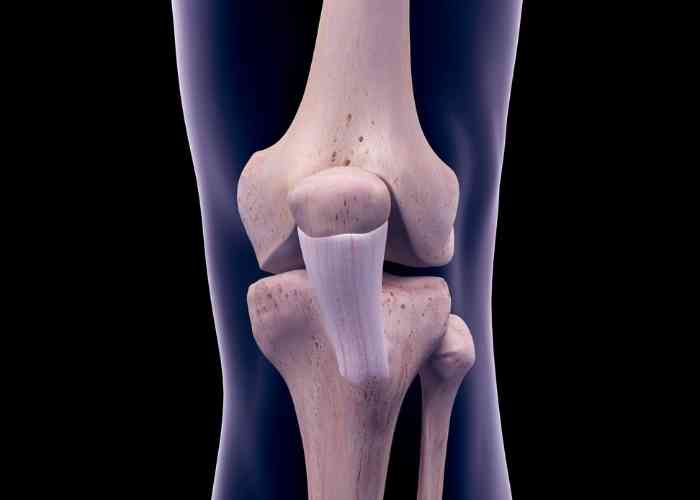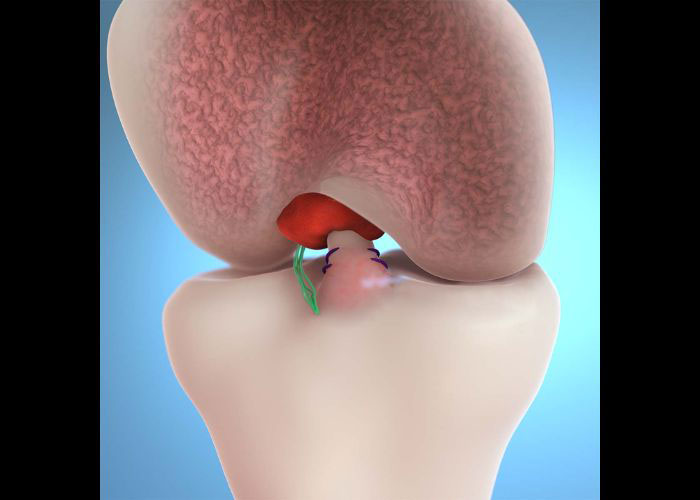What is the medial patellofemoral ligament?
Within the knee joint is an elastic-like tissue band known as the medial patellofemoral ligament (MPFL). This ligament originates from the lower end of the femur (thigh bone) and attaches to the patella (kneecap). Similar to a strong rubber band, the sole responsibility of the MPFL is to anchor the patella and prevent it from dislocating or moving outside of the knee joint.

How does an MPFL injury occur?
The bones, tendons, ligaments, and cartilage are intricately designed to withstand a significant amount of stress with daily and athletic activities. The connection of the medial patellofemoral ligament (MPFL) between the end of the femur and the patella contributes to patellar stability. In the event of a traumatic blow to the knee or twisting injury this can result in patellar dislocation and subsequent partial or complete tear of the MPFL. Any injury or damage to the MPFL can disrupt this ligament structure and result in patellar instability. Athletes that participate in sports that include pivoting, such as basketball, tennis, and football, are most frequently affected by MPFL injuries. However, non-athletic individuals with an underlying knee abnormality, deformity, tissue hyperlaxity (“joint looseness”), or weakened leg muscles are at an increased risk of experiencing an MPFL injury. Dr. Ronak Mukesh Patel, orthopedic knee specialist serving patients in Sugar Land, Pearland, and the Houston, Texas area, has the knowledge and understanding as well as substantial experience in treating patients who have experienced a medial patellofemoral ligament injury.
What are the symptoms of a medial patellofemoral ligament (MPFL) injury?
One of the most common complaints of a medial patellofemoral ligament (MPFL) injury is knee pain with sitting or a sense of instability (“giving away”) of the knee. Some individuals also report generalized knee stiffness. Some other common symptoms of an MPFL injury can include:
- Swelling of the knee that is more noticeable after activity
- A “catching” sensation with straightening or bending the affected knee
- Knee instability or the feeling that the knee will “give way”
- A “crunching” or “cracking” sound with knee movement
How is an MPFL injury diagnosed?
A comprehensive medical history, including any precipitating injuries or prior knee conditions, is gathered through an interview with Dr. Patel. This is followed by a thorough physical examination to evaluate the strength and integrity of the medial patellofemoral ligament (MPFL). Diagnostic imaging studies are useful in confirming an MPFL injury. X-rays can identify if any bone-related damage occurred as a result of the initial injury. Magnetic resonance imaging (MRI) can measure the extent of injury to the MPFL and analyze the surrounding soft-tissue structures for additional damage.
What is the treatment for an MPFL injury?
Non-surgical treatment:
Most medial patellofemoral ligament (MPFL) injuries respond well to conservative therapies alone. This includes patients with a minimal dislocation of the patella, a normal patellar height at the time of injury, and those who did not sustain any additional knee injuries. Rest and gentle range of motion is strongly encouraged to allow proper healing of the ligament. Immobilization of the knee joint with a brace or other medical device may also be recommended. The pain and inflammation associated with this condition can be managed with ice and non-steroidal anti-inflammatory medications (NSAIDs). Typically, physical therapy is utilized for rehabilitation of the knee.
Surgical treatment:
Surgical intervention may be necessary for patients with a complete rupture of the medial patellofemoral ligament (MPFL) or when conservative treatment measures failed to provide symptom relief. Dr. Patel may surgically repair this ligament through a minimally invasive procedure involving a small camera (arthroscope) and specialized surgical instruments. During MPFL reconstruction, the damaged tissue fragments are excised and removed and the remaining healthy tissue is sutured back together. Occasionally, a tendon graft, either from the patient (autograft) or donor (allograft), may be implemented. This new ligament is situated as close to the native tissue as possible to provide a surface for the generation of new tissue.
MPFL Injury Specialist

The job of the MPFL in the knee is to anchor the patella and prevent it from dislocating or moving outside of the knee joint. Injury to the MPFL can cause knee instability and frequent kneecap dislocations. MPFL specialist, Doctor Ronak Mukesh Patel, provides diagnosis as well as surgical and nonsurgical treatment options for patients in Houston, Sugar Land, and Pearland, TX who have injured their MPFL in the knee. Contact Dr. Patel’s team today!








